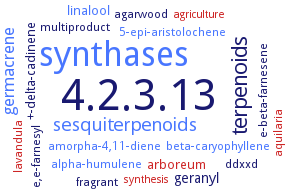4.2.3.13: (+)-delta-cadinene synthase
This is an abbreviated version!
For detailed information about (+)-delta-cadinene synthase, go to the full flat file.

Word Map on EC 4.2.3.13 
-
4.2.3.13
-
synthases
-
terpenoids
-
sesquiterpenoids
-
germacrene
-
geranyl
-
linalool
-
arboreum
-
+-delta-cadinene
-
lavandula
-
beta-caryophyllene
-
multiproduct
-
fragrant
-
alpha-humulene
-
agarwood
-
e,e-farnesyl
-
e-beta-farnesene
-
amorpha-4,11-diene
-
ddxxd
-
aquilaria
-
5-epi-aristolochene
-
synthesis
-
agriculture
- 4.2.3.13
- synthases
-
terpenoids
- sesquiterpenoids
- germacrene
-
geranyl
- linalool
- arboreum
-
+-delta-cadinene
- lavandula
- beta-caryophyllene
-
multiproduct
-
fragrant
- alpha-humulene
-
agarwood
-
e,e-farnesyl
-
e-beta-farnesene
- amorpha-4,11-diene
-
ddxxd
- aquilaria
- 5-epi-aristolochene
- synthesis
- agriculture
Reaction
Synonyms
(+)-delta-cadinene synthase, (+)-delta-cadinene synthase isoenzyme XC1, 2-trans,6-trans-farnesyl-diphosphate diphosphate-lyase (cyclizing, (+)-alpha-cadinene-forming), bifunctional sesquiterpene synthase 1, CAD, cadinene synthase, cadinol/cadinene synthase, CDN1, Cdn1-C1, Cdn1-C14, Cop4, cyclase, delta-cadinene, DCS, Dcs1, delta-cadinene cyclase, delta-cadinene synthase, EC 4.6.1.11, farnesyl diphosphate-delta-cadinene cyclase, PnCO/CDS, PnTPS2, sesquiterpene synthase, TPS1, TPS2
ECTree
Advanced search results
Application
Application on EC 4.2.3.13 - (+)-delta-cadinene synthase
Please wait a moment until all data is loaded. This message will disappear when all data is loaded.
agriculture
-
RNAi is used to disrupt gossypol biosynthesis in cotton seed tissue by interfering with the expression of the delta-cadinene synthase gene during seed development. It is possible to significantly reduce cottonseed-gossypol levels in a stable and heritable manner. The levels of gossypol and related terpenoids in the foliage and floral parts are not diminished, and thus their potential function in plant defense against insects and diseases remains untouched. A targeted genetic modification, applied to an underutilized agricultural byproduct, provides a mechanism to open up a new source of nutrition for hundreds of millions of people
synthesis
expression in Saccharomyces cerevisiae leads to a titer of (-)-alpha-copaene of 9 mg/l at 48 h and around 7 mg/l in Escherichia coli, and the titer of (+)-delta-cadinene is 6 mg/l in Saccharomyces cerevisiae and 3.5 mg/l in Escherichia coli


 results (
results ( results (
results ( top
top






